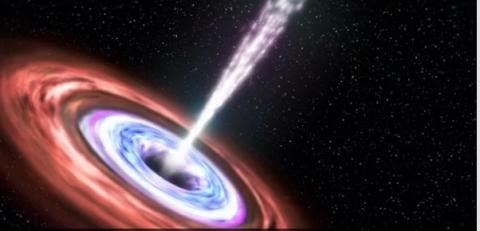 |
The idea of an object in space so massive and dense that light could not escape it has been around for centuries. Most famously, black holes were predicted by Einstein's theory of general relativity, which showed that when a massive star dies, it leaves behind a small, dense remnant core. If the core's mass is more than about three times the mass of the Sun, the equations showed, the force of gravity overwhelms all other forces and produces a black hole.
|
| |
|
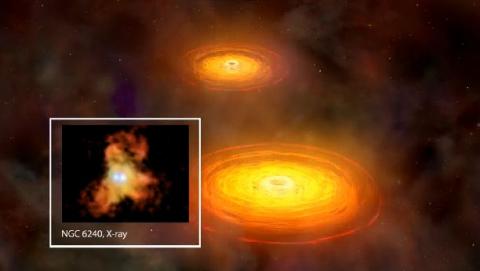 |
Scientists can't directly observe black holes with telescopes that detect x-rays, light, or other forms of electromagnetic radiation. We can, however, infer the presence of black holes and study them by detecting their effect on other matter nearby. If a black hole passes through a cloud of interstellar matter, for example, it will draw matter inward in a process known as accretion. A similar process can occur if a normal star passes close to a black hole.
In this case, the black hole can tear the star apart as it pulls it toward itself. As the attracted matter accelerates and heats up, it emits x-rays that radiate into space. Recent discoveries offer some tantalizing evidence that black holes have a dramatic influence on the neighborhoods around them - emitting powerful gamma ray bursts, devouring nearby stars, and spurring the growth of new stars in some areas while stalling it in others.
|
| |
|
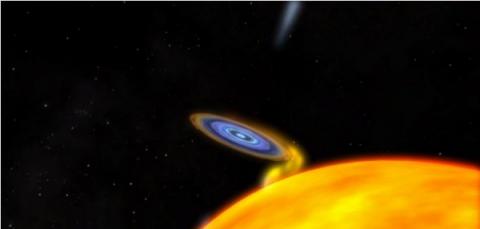 |
Most black holes form from the remnants of a large star that dies in a supernova explosion. (Smaller stars become dense neutron stars, which are not massive enough to trap light.) If the total mass of the star is large enough (about three times the mass of the Sun), it can be proven theoretically that no force can keep the star from collapsing under the influence of gravity. However, as the star collapses, a strange thing occurs. As the surface of the star nears an imaginary surface called the "event horizon," time on the star slows relative to the time kept by observers far away. When the surface reaches the event horizon, time stands still, and the star can collapse no more - it is a frozen collapsing object.
|
| |
|
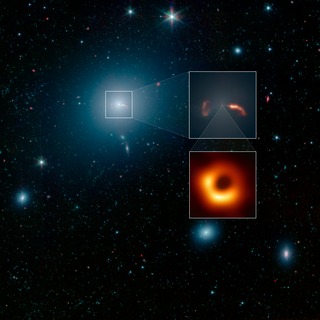 |
Although the basic formation process is understood, one perennial mystery in the science of black holes is that they appear to exist on two radically different size scales. On the one end, there are the countless black holes that are the remnants of massive stars. Peppered throughout the Universe, these "stellar mass" black holes are generally 10 to 24 times as massive as the Sun.
Astronomers spot them when another star draws near enough for some of the matter surrounding it to be snared by the black hole's gravity, churning out x-rays in the process. Most stellar black holes, however, are very difficult to detect. Judging from the number of stars large enough to produce such black holes, however, scientists estimate that there are as many as ten million to a billion such black holes in the Milky Way alone.
|
| |
|
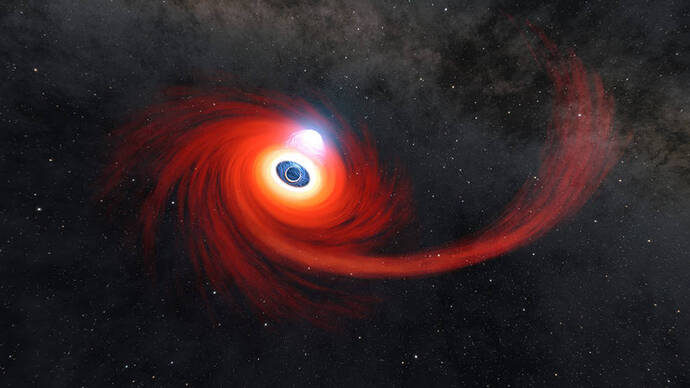 |
Recent observations of a black hole devouring a wandering star may help scientists understand more complex black hole feeding behaviors.Multiple NASA telescopes recently observed a massive black hole tearing apart an unlucky star that wandered too close. Located about 250 million light-years from Earth in the center of another galaxy, it was the fifth-closest example of a black hole destroying a star ever observed.
Once the star had been thoroughly ruptured by the black hole’s gravity, astronomers saw a dramatic rise in high-energy X-ray light around the black hole. This indicated that as the stellar material was pulled toward its doom, it formed an extremely hot structure above the black hole called a corona. NASA’s NuSTAR satellite is the most sensitive space telescope capable of observing these wavelengths of light, and the event’s proximity provided an unprecedented view of the corona’s formation and evolution, according to a new study published in the Astrophysical Journal.
|
|






